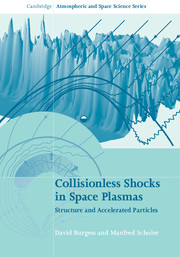Book contents
- Frontmatter
- Contents
- Preface
- Chapter 1 Shocks
- Chapter 2 Basic concepts
- Chapter 3 The quasi-perpendicular shock: macrostructure
- Chapter 4 The quasi-perpendicular shock: microstructure
- Chapter 5 The quasi-parallel shock
- Chapter 6 Diffusive shock acceleration
- Chapter 7 Coherent shock acceleration
- Chapter 8 Electron acceleration
- Chapter 9 Global and modified shocks
- Appendix Simulation techniques
- References
- Further reading
- Index
Preface
Published online by Cambridge University Press: 05 August 2015
- Frontmatter
- Contents
- Preface
- Chapter 1 Shocks
- Chapter 2 Basic concepts
- Chapter 3 The quasi-perpendicular shock: macrostructure
- Chapter 4 The quasi-perpendicular shock: microstructure
- Chapter 5 The quasi-parallel shock
- Chapter 6 Diffusive shock acceleration
- Chapter 7 Coherent shock acceleration
- Chapter 8 Electron acceleration
- Chapter 9 Global and modified shocks
- Appendix Simulation techniques
- References
- Further reading
- Index
Summary
The study of shock waves in collisionless plasmas has a long history of over 50 years. That of shock waves in gas dynamics has roots which go back to the foundations of applied mathematics in the twentieth century, the nature of hyperbolic systems of equations and the physics of blast waves. Much of this early work was associated with military research, and some of the earliest work on shock waves in plasmas started from a similar background. However, in the early 1960s it was in space that truly collisionless shocks were first observed. With the advent of high-resolution space observations a fundamental challenge came into being: how can nonlinear collective processes replace the action of particle collisions and lead to thin shock waves in a collisionless plasma? In other words: how do collisionless shocks work?
With the growing exploration of space and better understanding of the plasma physics of the heliosphere, the importance of shocks has become evident. Shocks are formed around the planets in the supersonic flow of the solar wind; they are formed ahead of the impulsive flows of coronal mass ejections, and at the steady interaction regions between solar wind with different speeds; the entire region of the solar wind is defined by an outer boundary, the solar wind termination shock, where the flow transitions to subsonic as it comes into balance with the interstellar medium. In parallel to our increasing understanding of solar system shocks, it has become obvious that shock waves will arise in many other astrophysical systems, and that often the physics will be dominated by collisionless processes. A widely cited example is the shock wave driven by a supernova remnant; such shocks are understood to be vital for explaining the majority of cosmic ray acceleration.
In writing this book we had three aims in sight. We felt there was a need for a graduate level textbook that brought together the physics of collisionless shocks as found in the heliosphere, with an emphasis on the theoretical underlying physics of shock waves in plasmas.
- Type
- Chapter
- Information
- Collisionless Shocks in Space PlasmasStructure and Accelerated Particles, pp. ix - xPublisher: Cambridge University PressPrint publication year: 2015



